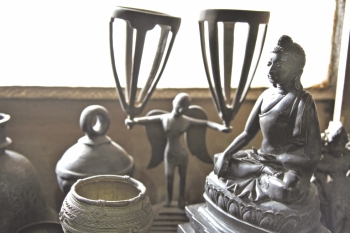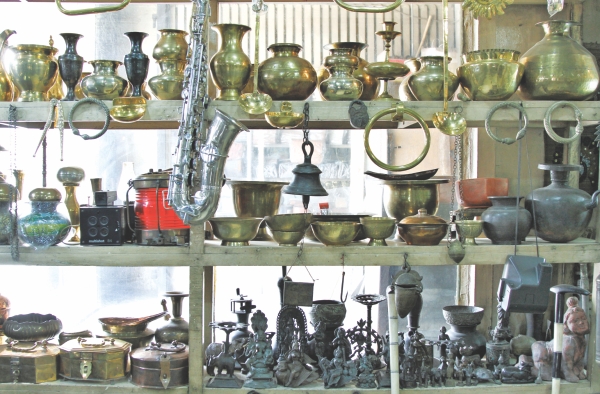| Home - Back Issues - The Team - Contact Us |
 |
| Volume 11 |Issue 05| February 03, 2012 | |
|
|
Lifestyle The New, the Old, the Unknown Soraya Auer
Copper and brass pots, jugs, plates and statues are perhaps the most common sight when entering any 'antique' or 'handicrafts' shop in Dhaka. The intricate designs and smooth shapes of these items make them nice to buy and easy to use. However, you are also probably not the only one to have one in your home. The reproduction of antiques, big and small, leaves many customers wondering whether what they buy is genuinely old or authentically new. Saima Hanley came out of one Gulshan 'handicrafts' shop with a pair of brass horses. “I'm sure these little statues aren't old, though they've been made to look it,” says Saima, who is a teacher in the US. “I've just bought them as souvenirs to put in my classroom so I don't mind.” “I've actually seen the original artists in Savar give these types of statues a finish that makes them look old,” says Fahmid Islam, who is interested in handicrafts and interior design. “They showcase their work in exhibitions in different clubs or embassies and a lot of foreigners who work here buy them. Because these artists don't have direct outlets here in Dhaka, they sell them through these antique shops in markets.” Most people are wise to the fact that many pieces are copies designed to look older than they are. And none of the shop keepers that I met in Gulshan 2 Market, a hub of antique shops, tried to hide it. “Some are reproduced and some are old. All our pieces may not be antique, but we get them second-hand,” says the shop owner of Hossain Handicrafts. The antiques business, which is slow moving, is neither catalogued nor regulated. Beyond the fact that you can't always distinguish between what is old and new, there is no way of ensuring the authentic antiques of Bangladesh's heritage are not lost, damaged or exported. In a first floor shop of Gulshan 2 Market, I saw a large beautiful Chinese vase with a detailed design. The salesman told me it was originally from a “private collection” and had been accidentally broken since coming to the shop.
As a frontier state, Bangladesh is where South Asia ends and South-East Asia begins. It is thus unsurprising how many of these shops boast beautiful Thai wall hangings, Chinese vases and Afghan carpets along with their Bengali artefacts. However, when these items arrived or who originally owned them remains a mystery. Smaller items such as medals, compasses, coins and watches could be from anywhere. Without any way of cataloguing or monitoring the market of antique goods, the business remains exclusive to connoisseurs in the know. “Only rich Bangladeshis, foreigners and embassy people, who know about and want antiques, buy them,” says Md. Faruque Islam, who, with his brother, runs his father's shops, Islam Handicrafts. “We have customers who come back and collect specific things like watches or coins,” says Mr Islam. In a neighbouring shop, I saw a grand dining room sideboard and almirahs from the British Colonial period. The sideboard had been kept in a storehouse for thirty years before reaching the shop floor and one almirah, due to lack of upkeep, looked completely different to another despite both being made from Burmese teak. “You wouldn't be able to get these reproduced,” says Rashel Chowdhuri, the owner of Alam Handicrafts. “It would cost too much and this wood is no longer available. It is also difficult to reproduce the craftsmanship.” Islam, who has a craved coffee table made from an old bed outside his shop, agrees. He says, “It's the craftsmanship that makes the pieces difficult to copy and valuable.” When asked how the prices differed between the real antiques and the pieces made to look old, Mr Islam says, “The antique pieces are normally more expensive but the price depends on the craftsmanship.” He points to a reproduced (but old looking) mahogany table and says, “Some people actually prefer new pieces that look old.” Despite the honesty of these antique sellers, customers are at their mercy as there is little proof beyond their words as to how old or how legitimate their products are. In at least five shops I was told that the piece I was looking at was 80 to 90 years old and when I asked where they came from, all of them answered saying that they either had 'brokers', 'suppliers' or 'dealers' in various parts of the country. It probably does not matter to most people whether a chair was made in 1935 or in 1955 or whether it came from North Bengal or Kashmir, as long as it looks striking. But when there is no clear knowledge and understanding about artefacts and furniture, the physical remnants of a culture, a part of history is effectively neglected. Surely not all the old and beautiful pieces of furniture were made during South Asia's British rule? Equally, the vague knowledge of where pieces come from begs the question: are they stolen? Ignorance is more bliss than it is a shortcoming, as shop keepers would prefer to say they have different sources to admitting they know they are selling stolen goods. Five years ago, Riffat Hossain tried to question one shop on the matter. “We were visiting a friend and saw a chair that looked very much like ones from our ancestral home in the country,” explains Riffat. “We asked where they got it from and they told us a shop in Gulshan 2 Market. When we went there, we saw more chairs with the same unique design. I asked where they got them from and they said they had someone who supplied them from Ghorashal Mia Bari – which is our house. “After going back to the house, we opened the storeroom where our chairs had been kept and we found all of them gone. By this time, our housekeeper, who was the only one with a key, was dead and there was nothing we could do.” Many of the shop keepers I spoke to told me how old homes and their contents were often sold off after heads of the family died and the younger generations did not value their antiques in the same way. While this story is plausible and sometimes true, many ancestral possessions, like silver plates and ceramic bowls, could also have found their way to the market place after being stolen. Without a system in place to catalogue, value and monitor the trade of antiques, big and small, it is a free market for those who can mishandle, steal or export antiquated goods. As more gold and silver coins are being discovered in the walls of Old Dhaka homes and Chinese ivory opium pipes are returning to circulation, there is a need to standardise and value the antiques business. It may well be a slow business, but it is also worth a lot of money. Even the reproduced pieces, like those old looking brass horses that Saima bought, will one day be antiques and valuable in their own right. They just need to be catalogued for what they are first: Brass Horse Statue, North Bangladesh, circa 2012. Copyright
(R) thedailystar.net 2011 |
||||

